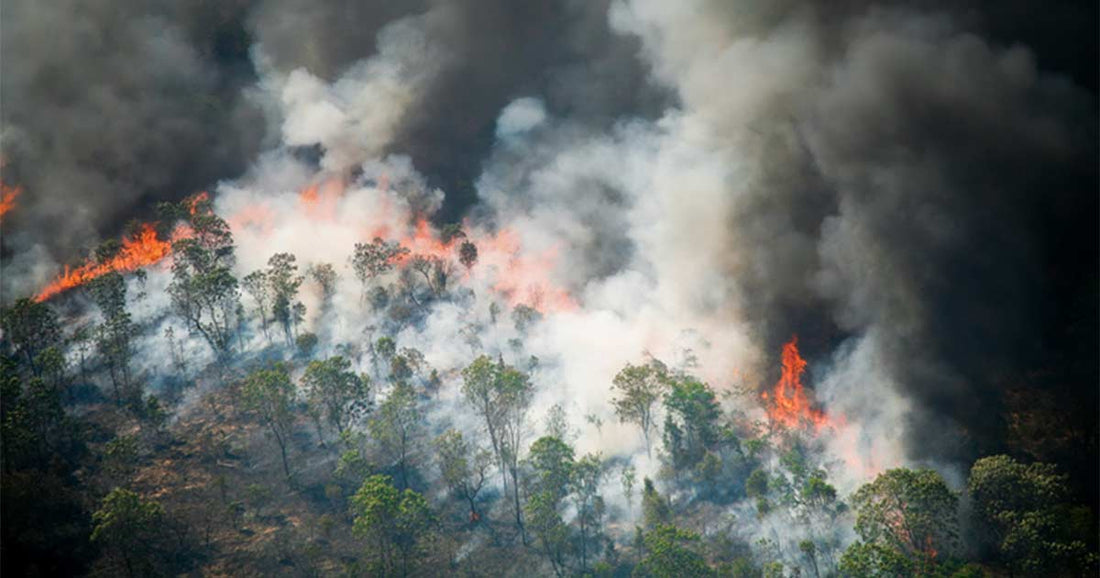Unraveling the Health Hazards of Escalating Wildfires: A Global Perspective

Share
The escalation of wildfires in regions such as California, Colorado, and Canada is alarming. The increase in both frequency and intensity of these wildfires over the recent years is an environmental catastrophe that seriously affects air quality and, consequently, human health.[1] Understanding the health risks of wildfire smoke inhalation is crucial in devising strategies to mitigate the problem.
The Far-Reaching Effects of Wildfire Smoke
Wildfires, particularly those in Canada with its vast forest reserves, generate immense amounts of smoke that contain a mixture of gases and fine particles from burning trees and vegetation. This smoke does not confine itself to the vicinity of the fire but is dispersed over significant distances by wind currents. This results in regional, national, and international degradation of air quality.[2]
Wildfire smoke comprises various substances, such as carbon dioxide, water vapor, carbon monoxide, particulate matter, hydrocarbons, and other organic chemicals. Among these, particulate matter, especially PM2.5 (particles having a diameter of less than 2.5 micrometers), is highly harmful to health as these minute particles penetrate deep into the lungs and even enter the bloodstream.[3]
Grasping the Health Implications
Respiratory System:The primary target of wildfire smoke is the respiratory system. Exposure to smoke results in symptoms like cough, wheezing, throat irritation, and breathlessness, akin to a sinus infection. Moreover, individuals with existing respiratory diseases like asthma or chronic obstructive pulmonary disease (COPD) are at a heightened risk.[4]
Cardiovascular System:
Studies have indicated that the ultrafine particles in wildfire smoke can lead to systemic inflammation, affect heart rhythm, raise blood pressure, and promote clotting, resulting in increased heart attack and stroke incidences.[5]
Immune System:
The immune system is also affected by wildfire smoke exposure. The toxins in the smoke incite an immune response that causes inflammation and oxidative stress, which might, over time, render individuals more susceptible to infections.[6]
Mental Health:There is also an undeniable impact on mental health, as the persistent threat of wildfires, the necessity for evacuations, and coping with the aftermath can lead to stress, anxiety, and depression. Poor air quality further aggravates these mental health issues by limiting outdoor activities and social engagements.[7]
Mitigating Health Concerns:
To protect public health, it is imperative to devise strategies like establishing early warning systems, ensuring the availability of high-grade air filters and masks, promoting indoor air purification, and educating vulnerable populations.
Introducing TrueCarbonCleanse™:
 TrueCarbonCleanse™ is a product that contains highly activated carbon, humates, Clinoptilolite (Cleanoptilite™), and other substances that bind to and eliminate toxins. This product prevents the reabsorption of toxins into the body, thus aiding detoxification.
TrueCarbonCleanse™ is a product that contains highly activated carbon, humates, Clinoptilolite (Cleanoptilite™), and other substances that bind to and eliminate toxins. This product prevents the reabsorption of toxins into the body, thus aiding detoxification.
TrueCarbonCleanse™ has potent toxin binders, including Baozene® Baobab Fruit Powder which promotes a healthy gastrointestinal tract and supports heavy metal binding due to high pectin content. Magnesium Oxide and Apple Fiber are also part of the formulation.
Cleanoptilolite™ (Clinoptilolite), a novel Crystalline Zeolite Nutrient included in the product, has shown potential as an antioxidant and a defender against heavy metals and other environmental toxins.[8]
Conclusion
The upsurge in wildfires and the ensuing decline in air quality warrant immediate attention and action. Addressing this environmental calamity is imperative for safeguarding public health. The situation underlines the intrinsic connection between the environment and health and
emphasizes the importance of fostering sustainable practices.
By proactively engaging in scientific research, educating communities, and utilizing tools like TrueCarbonCleanse™, we can empower individuals to protect their health against the detrimental effects of wildfire smoke. The path forward lies in acknowledging the interdependence of our environment and health, and channeling our efforts towards creating a balance between the two for a healthier and more sustainable world.
References:
- Westerling, A. L. (2016). Increasing western US forest wildfire activity: sensitivity to changes in the timing of spring. Philosophical Transactions of the Royal Society B: Biological Sciences, 371(1696), 20150178. doi: 10.1098/rstb.2015.0178.
- Liu, J. C., Pereira, G., Uhl, S. A., Bravo, M. A., & Bell, M. L. (2015). A systematic review of the physical health impacts from non-occupational exposure to wildfire smoke. Environmental Research, 136, 120-132. doi: 10.1016/j.envres.2014.10.015.
- Reid, C. E., Brauer, M., Johnston, F. H., Jerrett, M., Balmes, J. R., & Elliott, C. T. (2016). Critical review of health impacts of wildfire smoke exposure. Environmental Health Perspectives, 124(9), 1334-1343. doi: 10.1289/ehp.1409277.
- Delfino, R. J., Brummel, S., Wu, J., Stern, H., Ostro, B., Lipsett, M., ... & Sioutas, C. (2009). The relationship of respiratory and cardiovascular hospital admissions to the southern California wildfires of 2003. Occupational and Environmental Medicine, 66(3), 189-197. doi: 10.1136/oem.2008.041376.
- Wettstein, Z. S., Hoshiko, S., Fahimi, J., Harrison, R. J., Cascio, W. E., & Rappold, A. G. (2018). Cardiovascular and cerebrovascular emergency department visits associated with wildfire smoke exposure in California in 2015. Journal of the American Heart Association, 7(8), e007492. doi: 10.1161/JAHA.117.007492.
- Glencross, D. A., Ho, T. R., Camiña, N., Hawrylowicz, C. M., & Pfeffer, P. E. (2020). Air pollution and its effects on the immune system. Free Radical Biology and Medicine, 151, 56-68. doi: 10.1016/j.freeradbiomed.2020.01.179.
- Marshall, G. N., Schell, T. L., & Elliott, M. N. (2007). Distress and depression among adults seeking mental health treatment after a wildfire. Journal of Nervous and Mental Disease, 195(8), 670-674. doi: 10.1097/NMD.0b013e31811f4546.
- Kraljević Pavelić, S., Simović Medica, J., Gumbarević, D., Filošević, A., Pržulj, N., & Pavelić, K. (2018). Critical review on zeolite clinoptilolite safety and medical applications in vivo. Frontiers in Pharmacology, 9, 1350. doi: 10.3389/fphar.2018.01350.
